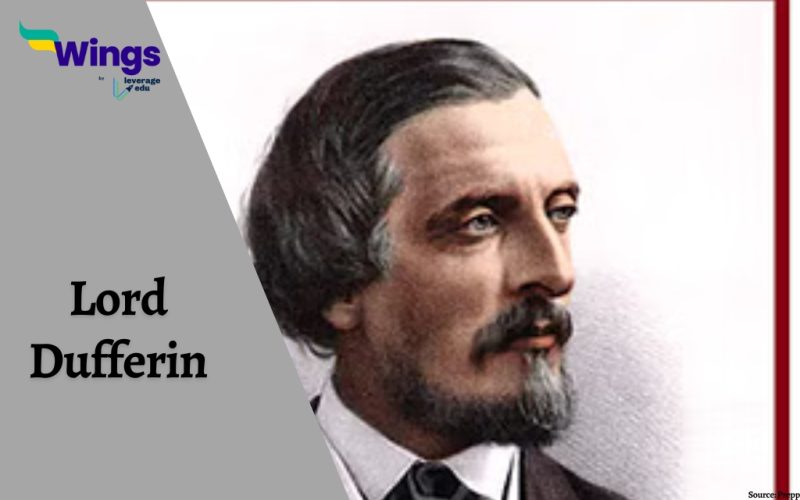Lord Dufferin served as the Governor General of India and Viceroy from 1884 to 1888. It was during his time that the Third Burmese War happened, eventually leading to the annexation of the entire Burma followed by the exile of the Burma ruler to India. Being the eighth Viceroy on the list of Viceroys of India, Lord Dufferin saw numerous major events unfolding in the country. In this blog, we will explore the historical background of Lord Dufferin and the most important events that took place during his time in India. Let’s begin.
Table of Contents [show]
Historical Background of Lord Dufferin
Here are a few important points on the historical background of Lord Dufferin:
- Lord Dufferin was born on 21 June 1826 in Florence, Italy.
- He received early education at Eton, Christ Church, and Oxford.
- During his lifetime, he acquired numerous diplomatic positions such as the post of British Commissioner in Syria (1860), Under Secretary of State for India in (1864), Governor-General of Canada in (1872), and so on.
- He became the Governor-General and Viceroy of India from 1884 to 1888 and was the successor of Lord Ripon.
- However, different communities including the natives and the Anglo-Indians were already angered by the reforms initiated by Lord Ripon.
- As a result, Lord Dufferin had to soothe the heating resentment and reclaim the community’s support.
Also Read: Who was Sir George Barlow?
What were the Important Events during Lord Dufferin?
Here is an overview of the important events that happened during the tenure of Lord Dufferin in India:
The Panjdeh Incident

- The Panjdeh Incident happened in the year 1885.
- It was a result of Russia’s expansion policy which was directed towards Afghanistan.
- With constant efforts and attacks, Russia seized Merv Oasis followed by the region of Panjdeh. Consequently, both Russia and the British military started preparing for a disastrous war.
- However, Lord Dufferin swiftly averted the upcoming destruction with his countless diplomatic efforts.
- A settlement was made in which Russia retained the Merv Oasis and Panjdeh and gave up the Zulfikar Pass which was among the most important pass.
- Apart from this, a joint Russian and British commission was also formed. It was given the responsibility to demarcate the northern boundaries of Afghanistan.
Also Read: Lord Ellenborough: Role in India
Third Burmese War

- Burmese people refused to accept the demarcation of its border with Manipur which was done by an English Commission. They threatened to destroy the boundary posts.
- This gave the British government a chance to declare war and seize more than one could imagine.
- However, the tensions ended up being a cold war as the Burmese did not take such demolishing actions. Nonetheless, things were still deteriorating between both parties.
- The Third Burmese War started with a minor disagreement between the Burmese government and the Bombay-Burma Trading Corporation, an English Company.
- The Bombay-Burma Trading Corporation was given a contract to manage forests.
- The Burmese government accused the Corporation of tax evasion and demanded it to not only pay its taxes but the penalty as well.
- On the other hand, the Company sought protection from the English government.
- Consequently, the English Commissioner asked the Burmese government to exempt the Corporation from such penalties. Additionally, the government was also directed to transfer the case to a representative of India’s governor-general.
- However, the Burmese government denied most of these requests which made the situation worse.
- Lord Dufferin, on the other hand, had already begun the preparations to launch a war against the Burmese government.
- In November 1885, the English finally occupied the Mandalay region followed by voluntary surrendering of King Thibaw.
- Afterwards, a proclamation was issued in January 1866 that led to the annexation of Burma to the British Empire.
Also Read: Formation of the Indian National Congress (1885)
Establishment of the Indian National Congress

- In May 1885, the then Viceroy of India gave Allan Octavian Hume his approval to establish an Indian National Union.
- It was no insignificant formation as the Union would be affiliated with the Government and serve as a forum for Indian public opinion.
- Eventually, this led to the formation of the Indian National Congress on December 28, 1885. It happened at the Gokuldas Tejpal Sanskrit College in Bombay which Womesh Chandra Bannerjee presided over during the first session.
- During this resolution, Congress members boldly expressed their dissatisfaction with the prevailing government and its governance system. Moreover, it also called for Council reforms.
- Following this session, Lord Duffering formed a Committee to reform the councils, eventually leading to the Indian Councils Act 1892.
Relevant Blogs
| Lord Cornwallis | Lord Curzon |
| Lord Lansdowne | Lord Dalhousie |
| Lord Canning | Lord Amherst |
| Lord Macaulay | Lord Lytton |
| Lord Minto I | Lord William Bentinck |
| Lord Charles Metcalfe | Lord Irwin |
FAQs
Lord Dufferin was one of the most prominent members of the Victorian society. He was a British public servant, best known for being among the most successful diplomats. Moreover, he was also the Governor General of India and Viceroy from 1884 to 1888.
There were numerous critical events during the time of Lord Duffering in India. Among others, the establishment of the Indian National Congress was a major one.
Lord Canning who was the Governor-General of India during the Indian Mutiny of 1857 also became the first Viceroy of India in 1858.
This was all about Lord Dufferin. We hope you liked our blog. If you want to read more articles like this you can visit our general knowledge page on Famous Personalities!
 One app for all your study abroad needs
One app for all your study abroad needs















 45,000+ students trusted us with their dreams. Take the first step today!
45,000+ students trusted us with their dreams. Take the first step today!
